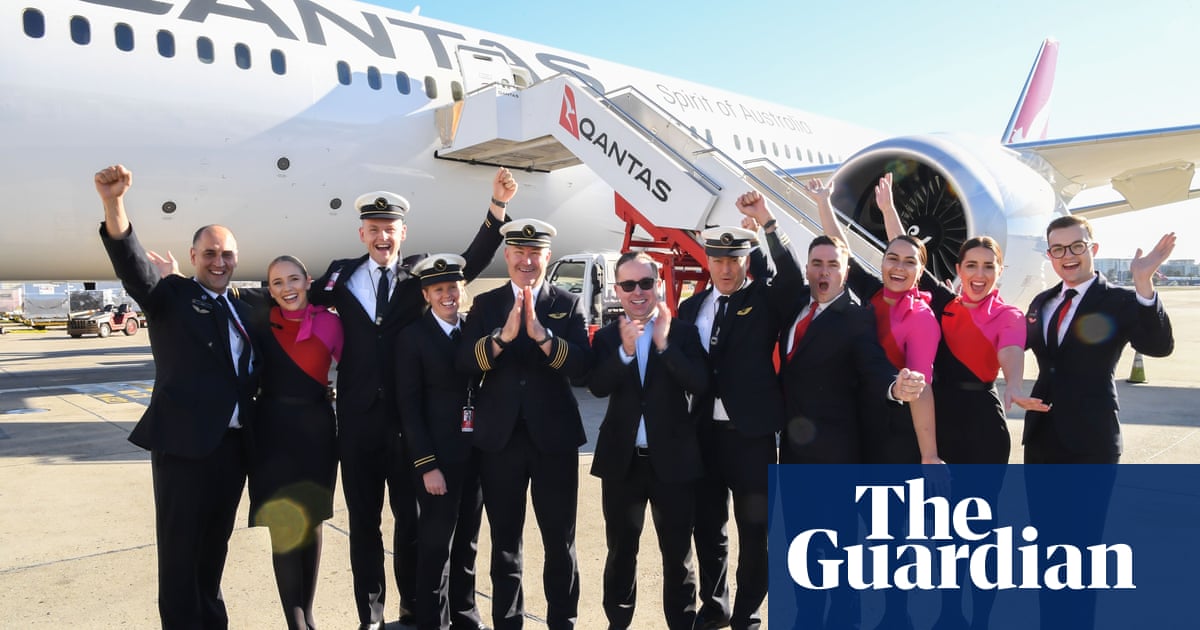Qantas Dreamliner completes longest ever commercial flight
Airline hails achievement after 19-hour New York-to-Sydney flight carrying 50 passengers and crew
They did the Macarena 10,972 metres above Las Vegas, dined on chilli- and lime-poached prawns and spicy “Jiangxi-style” cod and watched a fair few movies, including the Elton John biopic, Rocketman. Well, they had enough time: 19 hours and 16 minutes to be precise.
Aviation history was made at 7.43am on Sunday when Qantas flight QF7879 touched down at Sydney airport, completing the world’s longest ever commercial flight. It had taken off from New York’s JFK airport at 9.27pm on Friday night. Along the way, it produced the equivalent carbon dioxide emissions of burning more than 700 barrels of oil.
Just 49 people – including six pilots, six members of cabin crew including a chef, a handful of reporters, six frequent flyers and the airline’s chief executive, Alan Joyce – were on board the Boeing Dreamliner flight, designed to test whether passengers can endure the physical and mental effects of extremely long aeroplane journeys.
The flight was restricted to such a small number of passengers in order to ensure that it was light enough to make it all the way to Australia on one tank of fuel. In order to reduce the weight, strict restrictions were put in place, including limiting passengers’ luggage and destocking most of the bar. All the passengers were in business class.
🇺🇸 Touchdown! 🇦🇺
19 hours, 15 minutes
New York to Sydneyhttps://t.co/v39ZrePTJR#QF7879 #ProjectSunrise pic.twitter.com/7A42JkgMyA— Flightradar24 (@flightradar24) October 19, 2019
The plane was loaded with 101 tonnes of jet fuel, which made up almost half the total weight of the plane on takeoff. A Qantas spokesman was unable to explain how much carbon dioxide the flight created, but said all carbon emissions from the flight would be offset. The spokesman suggested that the carbon footprint of the direct flight would be less than that created by a two-leg journey because most energy used in flying is on takeoff.
The International Civil Aviation Organization, which is part of the United Nations, estimates that 3.15 grams of carbon dioxide are produced for every gram of jet fuel burned. This would suggest that the flight created about 310 tonnes of carbon dioxide – the equivalent to the CO2 emitted by the use of four full tankers of petrol or that of about 718 barrels of oil, according to the US Environmental Protection Agency.
Britain’s Committee on Climate Change said any new flights that expanded the market for long-haul travel would hinder the legally binding commitment to net-zero emissions by 2050.
Won’t somebody please think of the carbon pic.twitter.com/srzuNJ3ZnT
— SkepticalHippoEyes (@SkepticalHippo_) October 19, 2019
The flight covered 16,200 kms (10,200 miles) – about 900km further than the current longest commercial flight between Singapore and New York.
In an onboard interview in his Qantas-branded grey pyjamas, Joyce said: “This is the last frontier in aviation, being able to fly from the east coast of the United States to the east coast of Australia.”
The flight, on a brand new Boeing 787-9 Dreamliner named Kookaburra (a type of Australian kingfisher), was the first of three test flights exploring the practicalities of ultra-long -distance commercial aviation as part of Qantas’s Project Sunrise. Next month, Qantas will test a direct flight from Heathrow to Sydney, which will set a new distance record of 17,000km and take about 19.5 hours.
Joyce said upon landing in Sydney: “This is a really significant first for aviation. Hopefully, it’s a preview of a regular service that will speed up how people travel from one side of the globe to the other.
“We know ultra-long-haul flights pose some extra challenges, but that’s been true every time technology has allowed us to fly further. The research we’re doing should give us better strategies for improving comfort and wellbeing along the way.”
The passengers boarding the flight at 9pm in New York were told to reset their watches to Sydney time as soon as they boarded, and were kept awake with the lights on for six hours and served a spicy soup and fish lunch designed to keep them up for longer to reduce jetlag. The chef said he had been preparing the meals on the flight for three days.
As the flight flew over Las Vegas, passengers were led from their business class seats to the empty economy cabin in a rendition of La Macarena designed to get the blood pumping around their bodies.
Pilots, passengers and crew were also subjected to a battery of health and wellbeing checks designed to test the effects of ultra-long-haul flying. All crew members wore activity monitors and completed sleep diaries and alertness logs during the flight, and in the two weeks leading up to it.
Cameras were mounted in the cockpit to “record alertness cues and operational activities” and the pilots wore EEG (electroencephalogram) brain monitoring equipment to monitor them for alertness and sleep.
With demand for air travel rapidly growing and aircraft performance improving, carriers are increasingly looking into ultra-long-haul travel. The International Air Transport Association expects the worldwide number of annual passengers to increase from 4.6 billion this year to 8.2 billion by 2037.
Qantas captain Sean Golding said flying the plane was the highlight of his career. “The flight was very successful from two components,” he said. “The first one was research. And also the feat of distance – that flight last night was 16,200 kilometres. We were airborne for 19 hours and 16 minutes, and we landed here in Sydney with a comfortable 70 minutes of fuel.”
The QF7879 flight landed in Sydney a few minutes before the airline’s regular New York to Sydney service QF12, which stops in Los Angeles. QF12 had taken off from New York three hours before QF7879.




